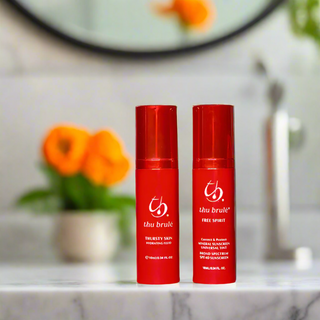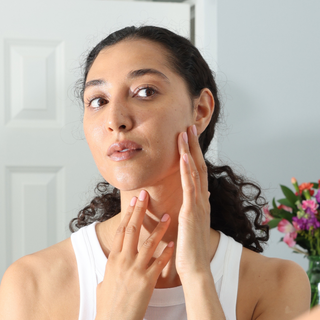In 2013 a very influential scientific review article was published which identified 9 hallmarks of aging. Since then, the authors published a more recent article in 2023 that updated and expanded the list to 12. The beauty industry has and continues to use this information as a guide for growth, inspiration and innovation.
Aging is defined as the continual loss of biological function and the reduced ability to recover over time. Aging is influenced by genetics, lifestyle and environmental factors. The 12 hallmarks of aging are focused on the cellular and molecular level and are responsible for general aging as well as skin aging. These hallmarks lead to the visual signs of aging we try to prevent.
The hallmarks of aging (Figure 1) are divided into 3 groups: primary, antagonistic, integrative. These groups are interconnected and a change within one hallmark or group can affect or worsen another hallmark in a different group. Primary causes of damage refer to hallmarks that are connected to core genomic aspects. Antagonistic hallmarks are processes that are designed to protect the body but can become harmful when dysregulated. Lastly, integrative hallmarks refer to the downstream effects of both the primary and antagonist hallmarks. Regardless of group, the hallmarks are quite complex and because of this, the ones that have a more digestible connection to skin health will be highlighted below.

Figure 1: The 12 hallmarks of aging: genomic instability, telomere attrition, epigenetic alterations, loss of proteostasis, disabled macroautophagy, deregulated nutrient-sensing, mitochondrial dysfunction, cellular senescence, stem cell exhaustion, altered intercellular communication, chronic inflammation, dysbiosis. Image from López-Otín, Carlos et al.
Cell, Volume 186, Issue 2, 243 – 278.
Primary causes of damage
- Genetic instability
o Genetic instability encompasses biological aspects such as nuclear DNA, mitochondrial DNA and nuclear architecture. Each of these are affected by both exogenous and endogenous factors from extrinsic and intrinsic sources. The body has many DNA repair and maintenance processes but as we age combined with compounding damage, these mechanisms become less efficient.
- Telomere attrition
o To start, a telomere is chemical structure located at the end of chromosomes that is designed to protect the chromosome by binding to a protective protein complex. This is one of the major areas where DNA damage occurs as replication enzymes cannot copy this region. The telomere region shortens with each replication which introduces genomic instability. There are enzymes that can extend the telomere end however, many mammalian cells cannot express it. The shortening of this region has a handful of negative effects on various molecular processes which can result in major outcomes like the development of disease. The telomere shortening rate is influenced by age, genetics, lifestyle and social factors.
Antagonistic processes
- Cellular senescence
o Cellular senescence is very pertinent to skin health. Healthy skin cells are constantly turning over and cycling. However, one option a cell has is to exit the normal cycle, stop growing and replicating and become senescent. It is a cellular response from acute or chronic damage (telomere shortening) and environmental factors are heavily tied to cellular senescence. When a cell becomes senescent it means it can no longer undergo cell division, but it also doesn’t die. These cells release signaling molecules that cause inflammation and can convert healthy cells which is why they have coined the term “zombie cells”.
- Mitochondrial dysfunction
o The mitochondria is often referred to as the “powerhouse” of the cell and is responsible for generating most of the cell’s energy (ATP). Because of its critical role, as mitochondria function declines with age it leads to increased concentrations of reactive oxygen species (ROS) which further damages the mitochondria itself and may trigger premature inflammation and cell death.
Integrative hallmarks
- Altered intercellular communication
o As we age, our intercellular communication within the body becomes less efficient. This negatively impacts homeostatic and hormetic regulation. In addition, neural, neuroendocrine and hormonal signaling are affected with age. Protein components within the extracellular matrix become damaged (elastin fragmentation, collagen crosslinking, tissue fibrosis) causing it to stiffen. This response also affects the function of senescent cells which can cause metalloproteases to secrete further damaging the extracellular matrix.
- Chronic inflammation
o Aging typically leads to inflammation known as “inflammaging” which refers to the systemic increase of inflammation response. An increase in the concentration of inflammatory cytokines and biomarkers can lead to an increased risk to many diseases. This hyperactivity also results in a weakened immune system response.
Aging and the hallmarks of aging are accelerated and enhanced when in combination with environmental factors. The most damaging environmental factors are UV exposure and pollution. These increase oxidative stress within the body damaging critical proteins and lipids. This damage cascades into slowing or impairing skin cell renewal and increasing cellular senescence leading to chronic inflammation and visual signs of aging.
The skin serves as a snapshot to our overall health and is often a great way to identify or diagnose various conditions. Aging is natural and while often challenging, should not always be interpreted as a negative. Even though aging is unavoidable, we can make choices (wash your face at night, use sunscreen every day, use enough sunscreen, cover as much skin as much as possible when going outside, etc.) that promote graceful aging. This will not only lead to looking and feeling better but also being healthier for longer.








